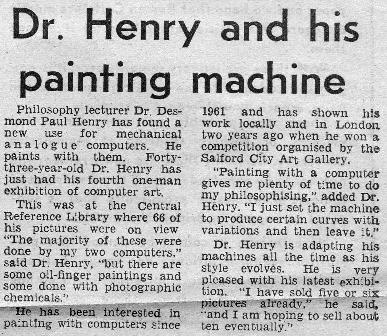One of the greatest sources of confusion concerns the impact of technology on social change. When we survey history, we see patterns which appear to suggest that steam power caused the industrial revolution, and the various social and political transformations which accompanied it. Obviously, online shopping needed the internet; the collapse of the high street could also be seen to be collateral damage from this, as was highlighted in this interesting (and rather depressing) piece about Bolton this week:
https://www.theguardian.com/cities/2017/aug/23/bolton-response-market-city-decline. But this causal connection between technology and social change is what is called "technological determinism" - and it clearly isn't true. Yet because a causal link between technological innovation and social change is constructed, a mindset sets in within institutions like universities and government which sees that the solution to social problems like housing, welfare, employment or health is technological innovation. But it tends to produce new problems rather than solutions.
We need a new theory which connects technological innovation to social change. I've begun to think that we look at the wrong things if we examine what new tools can do - what psychologists call their "affordances". Rather than doing this, there is a simpler starting point: all new tools provide new ways of doing things. That is, basically, the definition of a tool:
it creates a new option for acting.
Today we are continually bombarded with new options for acting: new online communication services (FaceTube), new ways of cutting mobile phone bills (LebaraFone), new ways of getting about (UberLyft), and so on. Our daily conversations often go something like "I use x, it's new - have you tried it? Much better than y".
There are a number of things about
options which need to be considered. Any option has to be
selected. We use all kinds of techniques for making selections - habit is the most powerful one - but the trouble of deciding on an option is
work. David Graeber calls this "imaginative labour". If you give somebody more options, that's more work.
From a more scientific perspective, if the number of options for acting is increased, then the probability that any particular option is selected decreases. If the probability of selecting an option decreases, the chances of somebody else guessing the option you have chosen also decreases. If the other person is not familiar with the scale of options you are selecting from, there is no chance of them guessing. This can make communication more difficult. There is no point in communicating a message to a friend through Twitter if they are not on Twitter.
In order to communicate, it is important that the range of options available to somebody sending a message is the same as the options available to a person receiving a message. If this isn't the case, then there is a chance that something will be selected at one end which cannot be selected at the other. The same thing applies to language: to understand a message, the receiver needs some idea of the inner machinery (psychology) of the person uttering the message so that they can understand how the selection of words was made. These basic principles grow from Ashby's Law of Requisite Variety in cybernetics: that in order to manage the complexity of system a, system b must have an equal or greater amount of complexity. One way of expressing this is through Shannon's information theory which measures the complexity of communications in terms of their "surprisingness", or the degree of uncertainty associated with them.
If adding a new option reduces the probability of selecting an option, and the probability of guessing what option is selected, then uncertainty is increased. Technological innovation does nothing but increases uncertainty.
Because of this, it is incorrect to say that "technology takes people's jobs". Institutions make people redundant, not computers. What causes institutions to do this is the their own reaction to the uncertainties produced by technology and other things in their environment. It is the effect of uncertainty on existential fears of managers, company directors, government ministers and so on which result in the misery of redundancy for staff (and never redundancy for those making the decisions about redundancy!). They tend to respond to it by off-loading their existential crises onto their employees as they seek to defend the structures of their institution in an increasingly uncertain environment.
Present crises of employment, equality, political expression, and institutional corruption are directly the result of institutions struggling to maintain themselves in an increasingly uncertain environment. As institutions seek to defend themselves by reinforcing their structures, sacking staff, and attempting to bend to "market conditions", they feed a growing political crisis which has the effect of ramping-up uncertainty in their environment. It is a positive feedback situation. Political uncertainty leads to new environmental complexities to which the institution has to adapt, sacking staff, reconfiguring courses, etc. Gradually institutions eat themselves.
At the heart of the problem is the way society manages its uncertainty. Traditionally, institutions like churches, universities, hospitals and government have been the means of managing uncertainty, which institutions have done by attenuating the environment and forcing individuals through regulated pathways. This worked because uncertainties could not proliferate because the transformation of means of doing things was a slow process. Computers change that. The transformation of means of doing things is rapid, and the growth of uncertainty is relentless. Institutions in their traditional form are not fit for purpose to manage uncertainty. Indeed, they make the situation worse.
The future of the management of uncertainty in society rests with effective use of technology and self-organisation between individuals. This will not replace universities and hospitals completely. But it will do many of the things which we currently associate with institutions. Meanwhile, the dinosaur institutions will hang on. Vice-chancellors will grab as much as they can to preserve their status and identity whilst things fall apart around them. Some of them will even give unwise interviews to national newspapers about how "well" they are doing. There is no better sign of the crisis we are in than this yacht-owning vice chancellor:
http://www.telegraph.co.uk/education/2017/08/01/university-chiefs-should-not-ashamed-salaries-says-yacht-owning/.
My thoughts this week are with those he's just made redundant.




